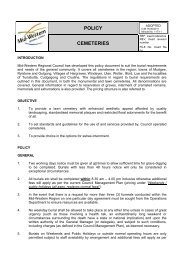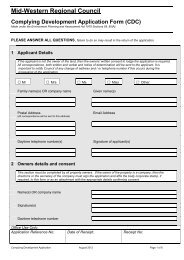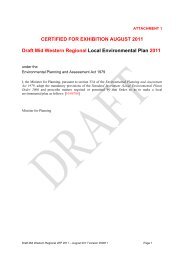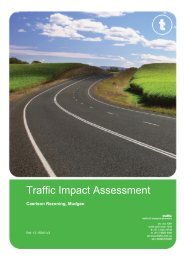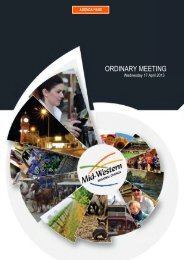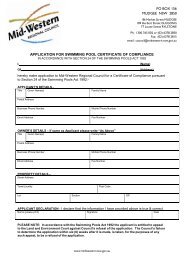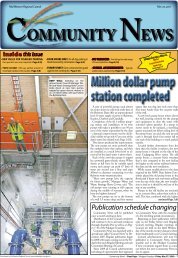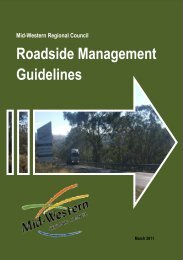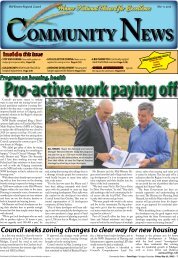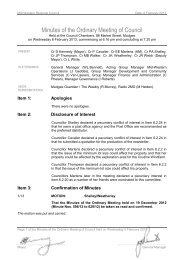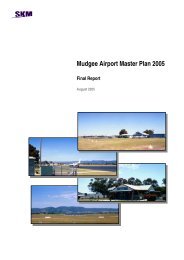preliminary soil salinity assessment - Mid Western Regional Council
preliminary soil salinity assessment - Mid Western Regional Council
preliminary soil salinity assessment - Mid Western Regional Council
You also want an ePaper? Increase the reach of your titles
YUMPU automatically turns print PDFs into web optimized ePapers that Google loves.
number of piles of material containing <strong>soil</strong>, concrete, gravel and some fencing materials exist on thesite particularly on the lower slopes. It appears the site was graded after the pens and yards wereremoved however no information was found by council to confirm this observation.A brick building still exists on DP 534336 which was associated with the old saleyards and lateroccupied by the State Emergency Service. West of this building remains a concrete pad that waspreviously used as a truck washdown facility. Dirty water from this washdown facility is believed tohave been directed to the nearby leachate ponds.At the initial site investigation and <strong>soil</strong> testing on 15 th May 2012 DP 534336 also contained a numberof piles of materials used for road construction by <strong>Mid</strong>-<strong>Western</strong> <strong>Regional</strong> <strong>Council</strong>. These occupied alarge area of this parcel of land. A small area to the north west of DP534336 appears to be relativelyundisturbed, which was confirmed anecdotally by Mr Colin Box.The land has been cleared almost entirely with a small number of eucalypt trees retained on the hillin the south western corner of the site and other scattered trees that appear to have been plantedfor shade. Groundcover across the site consists of a variety of grass and weed species. The hill areahas a mixture of perennial native grass species, while the lower slopes are dominated by couch grass(Cynodon dactylon) and kikuyu (Pennisetum clandestinum).The previous land use at this site raises particular concerns regarding <strong>soil</strong> <strong>salinity</strong>. Animal waste(faeces and urine) contains salt, including sodium salt. The intensive animal stocking at saleyardsresults in a concentration of animal waste with a relatively high level of salt that can potentiallyaccumulate at the site or enter the environment from the site. The amount of salt to enter the <strong>soil</strong>and waterways, and the impact of this salt on the environment, will depend on a range of factorssuch as:Design of animal holding facilities including the floor material and compaction of the pensand yards, and slope of earthern floored facilities,Animal waste collection, storage and disposal system design,Design of dirty water management system including containment and disposal,Rainfall,Soil profile characteristics within and surrounding the facilities, andNatural ground and surface water systems.From the limited information available on the now removed saleyard facilities and wastemanagement at the site, it is likely that some leaching of salts may have occurred into the <strong>soil</strong> profileacross the site. The relatively steep slope of some of the land south of Saleyards Lane (depicted inAppendix B: Current Site Layout, Topography and Soil Pit Locations is likely to have assisted inminimising leaching of salts into the <strong>soil</strong> profile on these sloped areas where some of the pens andyards were located.However, on the lower slopes and across Saleyards Lane where it is understood dirty water wasdirected to the leachate ponds and low lying areas, leaching of salts into the profile have occurred.As salts dissolve in <strong>soil</strong> water and are mobile in <strong>soil</strong>, rainfall across the site since the saleyards wereremoved is likely to have led to leaching of salts through the <strong>soil</strong> profile or into groundwater and isPRELIMINARY SOIL SALINITY ASSESSMENT7



